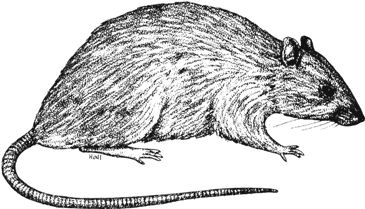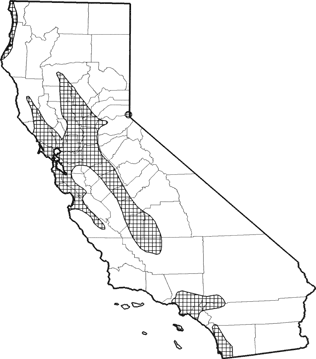
Norway Rat
Distribution, Abundance, and Seasonality
The introduced Norway rat occurs in the Central Valley, in the urban coastal areas of Los Angeles, San Diego, San Francisco, and Eureka, and in the Lake Tahoe area. Confirmed localities are lacking. In urban areas, it is more common in commercial sections, especially in restaurants and grocery stores, than in residential sections (Godin 1977). Abundant in garbage dumps and sewage systems (Ingles 1965). Occurs along streams and rivers, in wetlands, and sometimes in open fields (Godin 1977). May occur in riparian habitats, especially at lower elevations. Common in cropland, pasture, and urban habitats. Abundant in some agricultural areas and in dumps.

Range Map
Specific Habitat Requirements
Feeding: Omnivorous. Forages on ground for grains, fruits, eggs, insects, birds, mammals, garbage, and meat scraps. Food located by sense of smell. Visual acuity and depth perception poor beyond a few ft. Can detect minute quantities of toxic substances in food (Richter and Clisby 1941). At least 1/3 body weight in food is consumed daily. Food may be cached.
Cover: Extensive burrow systems are dug under buildings, in dumps, and in stream banks (Godin 1977). Burrows are 5-7.6 cm (2-3 in) in diameter, often 30 cm (12 in) deep, and 91 cm (36 in) long. Burrow entrances are multiple, and may be plugged lightly with vegetation or soil. The nest chamber is 10-15 cm (4-6 in) in diameter, and is used for refuge, a breeding nest, and as a place to eat (Godin 1977).
Reproduction: A nest lined with shredded plants, or other soft material, is constructed in the burrow.
Water: Water, or moist food, is required. In lab, about 90 ml (1.5 oz) of water is required each day (Godin 1977).
Pattern: Generally associated with unsanitary human habitation, with accessible garbage and sewers.
Species Life History
Activity Patterns: Primarily nocturnal, though also may be seen during the day. Active yearlong.
Seasonal Movements / Migration: Often none, but Norway rats occupying agricultural habitats may move to buildings during cold weather, returning in the spring. Rats occupying dumps and buildings usually do not move (Godin 1977).
Home Range: One colony ranged over an area 30 m (100 ft) in diameter (Davis et al. 1948). In the eastern U.S., home ranges averaged 707 m? (7606 ft?) (9.3-734 m? or 100-7900 ft?) in cities. The minimum range outside cities was about 93 m? (1000 ft?) (Barnett 1975).
Territory: Dominant males defend a territory containing several females (Godin 1977). Colonies consisting of several families share nesting and feeding areas. Within colonies aggression is low, but members of adjacent colonies fight vigorously (Godin 1977).
Reproduction: Breeds year-round, with peaks in spring and fall. Polygamous. Gestation period is 21-22 days. Litters average 7-8 altricial young (range 6-22). An average of 6 litters/yr raised (range 3-12). Weaning occurs at 3 wk; sexual maturity at 80-85 days (Calhoun 1962).
Niche: The Norway rat is an aggressive, omnivorous, moderate-sized rodent. It vigorously excludes (and preys upon) the black rat where they occur together. Prey to humans, hawks, owls, foxes, dogs, cats, mustelids, and snakes. Godin (1977) listed the chief diseases as salmonellosis, tularemia, leptospiral jaundice, Haverhill fever, and typhus fever. These diseases can decimate dense rat populations, and they can be transmitted to humans. Parasites include fleas, mites, ticks, cestodes, nematodes, and trematodes. Less arboreal than black rats; also semiaquatic.
Sources & References
California Department of Fish and Game, 1999.
California's Wildlife, Sacramento, CA.
Written by: P. Brylski, reviewed by: H. Shellhammer, edited by: R. Duke
Airola, D. A., ed. 1980. California wildlife habitat relationships program: Northeast Interior Zone. Vol. IV. Mammals. U.S. Dep. Agric., For. Serv., Lassen Natl. For., Susanville, CA. 255pp. Barnett, S. A. 1975. The rat: a study in behavior. Univ. Chicago Press, Chicago, Ill. 318pp. Calhoun, J. B. 1962. The ecology and sociology of the Norway rat. U. S. Dep. Health, Education, and Welfare, Public Health Serv. Publ. No. 1008. 288pp. Davis, D. E., J. T. Emlen, Jr., and A. W. Stokes. 1948. Studies on home range in the brown rat. J. Mammal. 29:207-225. Godin, A. J. 1977. Wild mammals of New England. Johns Hopkins Univ. Press, Baltimore, MD. 304pp. Ingles, L. G. 1965. Mammals of the Pacific states. Stanford Univ. Press, Stanford, CA. 506pp. Richter, C. P., and K. H. Clisby. 1941. Phenythis-carbamide taste thresholds of rats and human beings. Am. J. Physiol. 134:157-164.
California Animal Facts | California's Wildlife